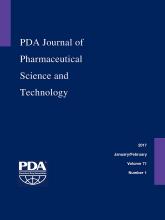Abstract
The European Pharmacopeia surface test to analyze the hydrolytic resistance is a common industrial method to understand and ensure the quality of produced glass vials. Hydrolytic resistance is evaluated by calculating the alkalinity of water extract from autoclaved vials by titration. As an alternative to this titration technique, a conductivity technique was assessed, which directly measures the ions in the water extract. A conductivity meter with a 12 mm diameter electrode was calibrated with a 100 μS/cm conductivity standard and carryover minimized by rinsing the probe in a water beaker per analysis. The limit of quantification at 1 μS/cm was determined as having a signal-to-noise ratio of 3 compared with the water blank. The conductivity method was selective for glass-composing elements (boron, sodium, aluminum, silicon, potassium, and calcium) within the vial extract. Accuracies of spiked conductivity standard within the range of 1 to 100 μS/cm were ±7% and had linearity with coefficient of determination (R2) of ≥0.9999. Intraday precision had a relative standard deviation (RSD) (n = 5) of ≤6% for spiked conductivity standard within the range of 1 to 100 μS/cm. Interday precision had a RSD (n = 4) of ≤6% for 10 vials from three glass vial lots. Conductivity of water extracts from nine sets of seven lots of glass vials had a precise linear relationship [R2 = 0.9876, RSD = 1% (n = 9)] with titration volumes of the same lots. Conductivity results in μS/cm could be converted to titration volumes in milliliters by a conversion factor of 0.0275. The simplicity, sample stability, and individual vial analysis of the conductivity technique were more advantageous than the current titration technique.
LAY ABSTRACT: The quality of glass vials used as primary containers in the pharmaceutical industry is of concern due to recent observations of glass flake-like delamination, or lamellae, under specific storage conditions. The current European Pharmacopoeia method to assess glass vial quality utilizes acid titration of vial extract pools to determine hydrolytic resistance or alkalinity. As an alternative to the European Pharmacopoeia method, the vial extracts were analyzed for conductivity, which directly determines the level of ions that were readily extracted from the vial surfaces. Lower quality glass would have greater surface defects that lead to higher ions extracted and higher conductivity value. The conductivity method was found to be suitable to measure the ions in water extracts and showed strong correlation with alkalinity. The advantage of the conductivity method over the alkalinity method was greater ease, lower volume requirements, stability, and flexibility in analysis.
- © PDA, Inc. 2017
PDA members receive access to all articles published in the current year and previous volume year. Institutional subscribers received access to all content. Log in below to receive access to this article if you are either of these.
If you are neither or you are a PDA member trying to access an article outside of your membership license, then you must purchase access to this article (below). If you do not have a username or password for JPST, you will be required to create an account prior to purchasing.
Full issue PDFs are for PDA members only.
Note to pda.org users
The PDA and PDA bookstore websites (www.pda.org and www.pda.org/bookstore) are separate websites from the PDA JPST website. When you first join PDA, your initial UserID and Password are sent to HighWirePress to create your PDA JPST account. Subsequent UserrID and Password changes required at the PDA websites will not pass on to PDA JPST and vice versa. If you forget your PDA JPST UserID and/or Password, you can request help to retrieve UserID and reset Password below.






